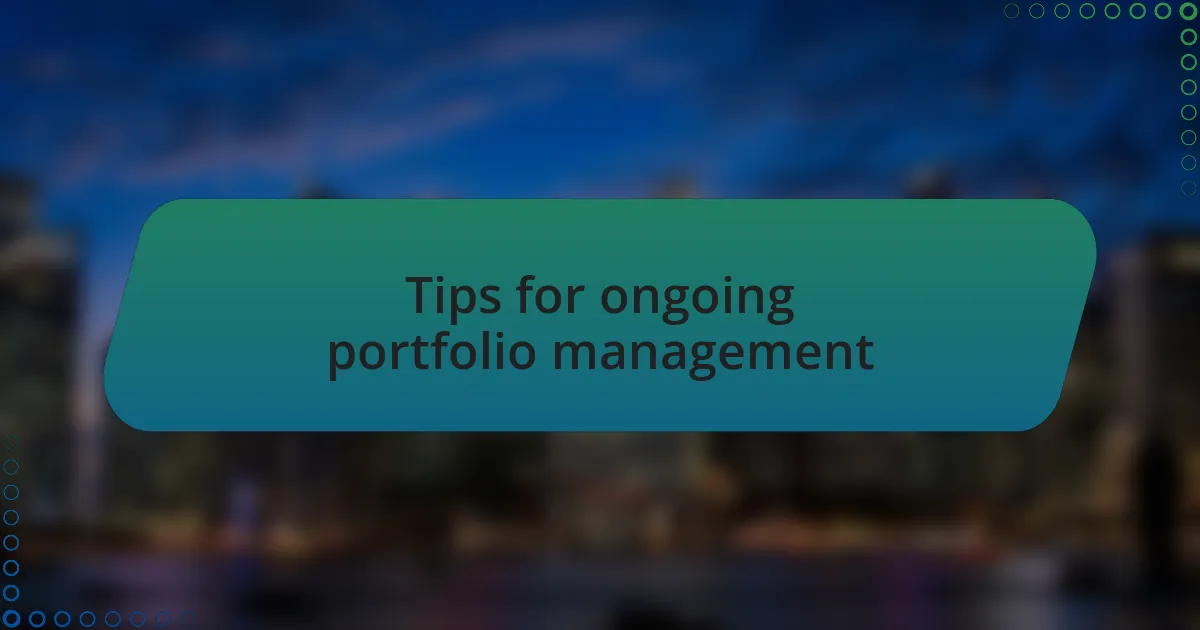Key takeaways:
- Diversification mitigates risk and enhances potential returns, similar to crafting a balanced meal with diverse ingredients.
- Incorporating various asset classes, including stocks, bonds, real estate, and international markets, can create a protective safety net during market volatility.
- Regular portfolio reviews and rebalancing are essential for maintaining alignment with financial goals and adapting to market changes.
- Staying informed about market trends empowers investors to make strategic adjustments for better performance.

Understanding diverse portfolio concepts
When I first delved into the concept of a diverse portfolio, I quickly realized it wasn’t just about spreading my investments across different assets. It felt more like crafting a well-balanced meal, where each ingredient plays a unique role in supporting the whole. Have you ever noticed how a poorly balanced diet can leave you feeling sluggish? The same goes for a portfolio lacking diversity—risk and instability can drain your financial vitality.
One critical aspect of diversification I learned is the importance of asset allocation. It’s akin to a chef deciding how much of each ingredient to use based on the dish’s flavor profile. For instance, I’ve found that mixing stocks, bonds, and real estate not only reduces risk but also enhances potential returns. Isn’t it fascinating how different asset classes respond to market changes, sometimes acting as a safety net when others falter?
I remember my early days of investing, where I relied heavily on tech stocks. It was thrilling at first; the profits came rolling in. However, when the market took a downturn, I felt the almost crushing weight of my unbalanced portfolio. This experience taught me the emotional resilience that comes from true diversification. It’s not just a financial strategy; it’s a mindset that nurtures confidence in uncertain times. Have you reflected on how your portfolio’s balance affects your peace of mind?

Importance of diversification in investing
Diversification is crucial because it helps to mitigate risk. When I first started investing, I believed that putting everything into high-growth stocks would guarantee success. However, during market corrections, I learned the painful lesson that relying solely on one sector can lead to significant losses. By spreading my investments across various asset classes, I found a much-needed cushion to soften the blows of market volatility.
One memorable moment in my investing journey was during a recession. My friends panicked, frantically selling off their shares in a few struggling companies. I had diversified my investments among stocks, bonds, and even some commodities, which allowed me to remain calm. It was a reassuring realization; my diverse portfolio felt like a safety net, keeping me afloat when others were drowning in fear. Have you ever considered how a diversified investment approach could shield you from unpredictable market shifts?
Ultimately, diversification empowers investors to seize opportunities while safeguarding against downturns. I often think about how, when I decided to include international markets in my strategy, it opened up new horizons for growth. By thinking beyond borders, I discovered industries and sectors that thrived even when my domestic investments struggled. Isn’t it liberating to recognize that a broad perspective can lead to unexpected and rewarding adventures in investing?

Types of investments for diversity
When it comes to building a diverse portfolio, one of the most effective strategies has been incorporating a mix of asset types. I’ve found that balancing investments in stocks, bonds, and real estate has offered not only protection against market fluctuations but also the chance to capitalize on different growth avenues. For instance, while tech stocks may soar during certain periods, real estate often provides steady returns that can buffer against stock market volatility—it’s like having a safety net and a climbing rope all at once.
Another investment type that I began exploring was commodities, such as gold and oil. I remember feeling hesitant at first; investing in something physical seemed foreign compared to shares in a company. However, during times of geopolitical tension, I was grateful that I had added these tangible assets to my portfolio. They not only acted as a hedge against inflation but also reminded me how diverse the investment landscape truly is—how often do we limit ourselves to what’s familiar?
Additionally, I realized the importance of including international markets in my diversification strategy. On a trip abroad, I couldn’t help but notice how industries in emerging markets were thriving. This inspired me to invest in foreign stocks, and I vividly remember the excitement of watching my investments grow in regions I had personally visited. Considering global investments can transform your perspective—aren’t we all a bit curious about how the world outside our borders is generating wealth?

Tips for ongoing portfolio management
When it comes to ongoing portfolio management, I’ve learned the value of regular reviews. I set aside time each month to evaluate my investments, reflecting on performance and adjusting based on market conditions. I can’t tell you how many times I’ve felt a rush of satisfaction when I identified an underperforming asset just in time, reminding me that active management is more than a task—it’s a commitment to my financial future.
Another tip that has served me well is staying informed about market trends. I recall a time when I followed a financial podcast that prompted me to reconsider my allocation in tech stocks. This awareness led me to pivot my investments, ultimately resulting in gains I hadn’t anticipated. Engaging with industry news not only enhances my knowledge but also empowers me to make decisions that keep my portfolio aligned with my goals.
Moreover, I always consider rebalancing my portfolio periodically. The first time I rebalanced, it felt akin to tidying up a messy room—I was astounded by the clarity it brought. By intentionally adjusting my asset allocation, I was able to maintain the desired risk level while ensuring that my investments aligned with my financial aspirations. Is your portfolio still aligned with your goals, or has it veered off course? Rebalancing can be the fresh perspective you need.